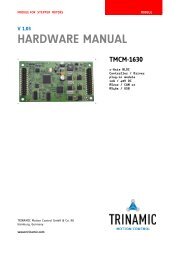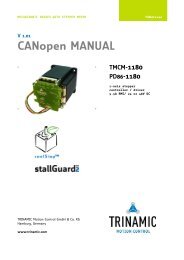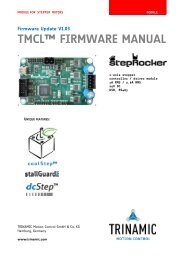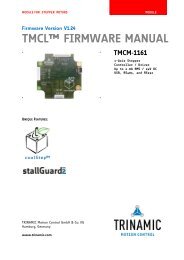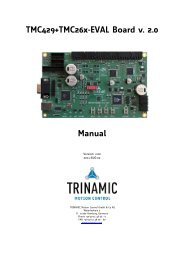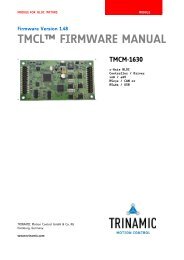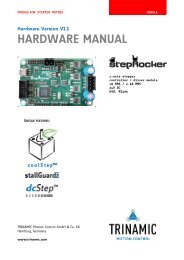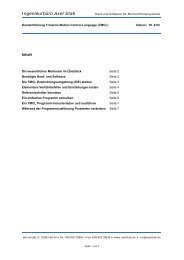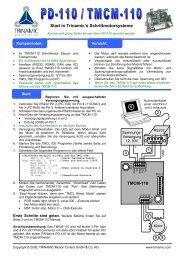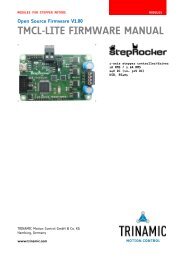TMCL™ Firmware Manual - Trinamic
TMCL™ Firmware Manual - Trinamic
TMCL™ Firmware Manual - Trinamic
You also want an ePaper? Increase the reach of your titles
YUMPU automatically turns print PDFs into web optimized ePapers that Google loves.
PD-109-57 V2 TMCL <strong>Firmware</strong> <strong>Manual</strong> (V1.00/2010-FEB-18) 13<br />
6 TMCL and TMCL-IDE<br />
The TMCM-109 module supports TMCL direct mode (binary commands or ASCII interface) and stand-alone<br />
TMCL program execution. You can store up to 2048 TMCL instructions on it.<br />
In direct mode the TMCL communication over RS232 and RS485 follows a strict master/slave relationship.<br />
That is, a host computer (e.g. PC/PLC) acting as the interface bus master will send a command to the<br />
module. The TMCL interpreter on it will then interpret this command, do the initialization of the motion<br />
controller, read inputs and write outputs or whatever is necessary according to the specified command. As<br />
soon as this step has been done, the module will send a reply back over RS232/RS485 to the bus master.<br />
The master should not transfer the next command till then. Normally, the module will just switch to<br />
transmission and occupy the bus for a reply, otherwise it will stay in receive mode. It will not send any<br />
data over the interface without receiving a command first. This way, any collision on the bus will be<br />
avoided when there are more than two nodes connected to a single bus.<br />
The <strong>Trinamic</strong> Motion Control Language (TMCL) provides a set of structured motion control commands.<br />
Every motion control command can be given by a host computer or can be stored in an EEPROM on the<br />
TMCM-109 to form programs that run stand-alone on the module. For this purpose there are not only motion<br />
control commands but also commands to control the program structure (like conditional jumps, compare<br />
and calculating).<br />
Every command has a binary representation and a mnemonic:<br />
The binary format is used to send commands from the host to a module in direct mode.<br />
The mnemonic format is used for easy usage of the commands when developing stand-alone<br />
TMCL applications with the TMCL-IDE (IDE means Integrated Development Environment).<br />
There is also a set of configuration variables for the axis and for global parameters which allow individual<br />
configuration of nearly every function of a module. This manual gives a detailed description of all TMCL<br />
commands and their usage.<br />
6.1 Binary command format<br />
Every command has a mnemonic and a binary representation. When commands are sent from a host to a<br />
module, the binary format has to be used. Every command consists of a one-byte command field, a one-byte<br />
type field, a one-byte motor/bank field and a four-byte value field. So the binary representation of a<br />
command always has seven bytes.<br />
When a command is to be sent via RS232 or RS485 interface, it has to be enclosed by an address byte at the<br />
beginning and a checksum byte at the end. In this case it consists of nine bytes.<br />
Copyright © 2010, TRINAMIC Motion Control GmbH & Co. KG



